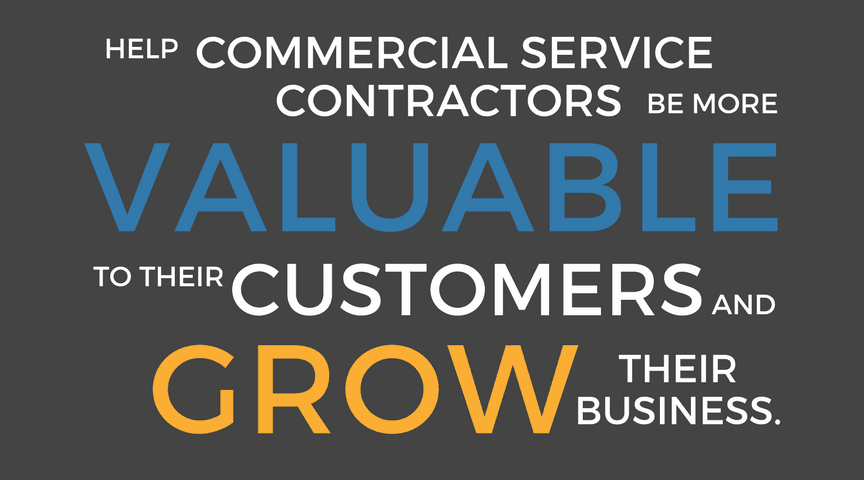Build a Services Brand that is Worth Something
ServiceTrade talks a lot about using technology and great customer service to increase the value of a service contractor’s brand. It is worth exploring what we mean when we talk about a brand.
What do we mean when we say brand?
As your personality makes you different from everyone around you, your company’s brand is a collection of characteristics that make it unique. Your brand is the truth about your company and what makes it special.

ServiceTrade’s mission
I used to work at a branding and marketing agency that helped companies define and communicate their brand. Brands are the fabric of the business – what it does, what it values, and how it engages with the world around it. A genuine brand should reflect what’s happening in the business during normal operations — not the aspirations of what anyone thinks should be happening now or in the future.
At the agency, we used an employee survey to help discover the truth of a company’s brand. One of the questions is “If <your company> was a car, what kind of car would it be?” I know it sounds like a silly question but it revealed so much. It wasn’t uncommon for owners and executives to claim high-end, high-cost luxury vehicles while people in the trenches in the lower reaches of the organizational chart identified with affordable, four-door family sedans. It was one of the strongest indicators of consensus or uncertainty across the company about the brand. For a fun exercise, ask this question of your employees and look at the range of responses.
Why is branding important?
A clear, engaging brand is as important as a person’s winning personality. Your brand sets expectations for what it’s like to work with you. Your brand is your reputation. It is what you are known as or known for. Your brand reputation should be protected as a valuable asset.
Besides establishing who you are, your brand defines what makes you different from your competition when someone cares to compare. Your brand helps people feel a connection to your company by understanding what it stands for and how it can help them. Your brand’s mission also directs your company’s initiatives and your employees in their work. The next time you face a tough decision or a rough patch, take a look at your brand promises and see where they direct you.
Elements of your brand.
Hopefully, it’s clear that your brand is more than marketing, it is how you work every day. But there are some tools in your marketing toolbox that help you communicate your brand:
- Logo
- There are countless logo styles. Putting your brand into words can help a talented designer create a logo that reflects your brand.
- Color palette
- Choose a suite of colors to use on all of your materials and use them consistently. Creation of a brand color palette is usually part of a logo design project.
- Imagery
- Here we’re mainly talking about the style of photos, videos, or illustrations that you use on your website and in your sales and marketing. Do you have a cartoon character or set of iconography that you rely on? Do you prefer photos of environments over photos of people? Give this some thought, and use these elements consistently.
- Tone of voice
- If you were in a law firm instead of a services company your tone would be formal business language. But in services, you can be more casual and talk in direct, simple language to your audience. Be thoughtful about how you write on your website and in your proposals. If you’re easy to talk to (or read), maybe they’ll also think you are easy to work with.
- Mission statement
- Mission statements are usually for internal use to make sure that everyone agrees with what kind of car the company is (going back to my favorite branding survey question.) Craft a short mission statement. Share it. Repeat it. Let your mission drive everything you do. ServiceTrade’s mission is in the image at the top of this post.
- Elevator message and key messages
- Your elevator message is used externally when someone asks “What does your company do?” If you ask any employee in the company, you should get a similar response that could be delivered in the short amount of time of an elevator ride.
Who cares about your brand?
Everyone who has a relationship with your company.
- Employees – Employees know what is expected of them as they deliver on your brand promises in their work.
- Customers – Customers reap the benefits of your brand promise in every interaction with you.
- Prospects – Your brand tells prospects if the things that matter to them matter to you.
- Community – The communities where you do your work should also see you living your values in visible ways.
Live your brand.
I have four tips for you for living your brand to keep your company focused on the things that matter.
- Be genuine about your brand and your mission.
- Use your mission as a touchstone for your daily decisions.
- Talk with your customers to learn if their perception of your brand matches yours.
- Don’t stop building up your brand. It should evolve as your business grows and moves forward.
Increase the value of your brand.
Let’s be clear – adding to the value of your brand means adding to your bottom line. Here are three things you can do to increase the value of your service contracting brand:
- Stop competing on price and sell a premium program that provides better outcomes to customers.
- Give your customers a modern, online customer service experience that reduces their risk and aggravation and makes them want to work with you forever.
- Enable and encourage your employees to make decisions that support the mission and the brand so they can embody it fully.
Here are some resources that can help you increase the value of your service contracting brand.
- Webinar: Don’t sell on price. Sell a premium program.
- Webinar: SWOT plan for service contractors
- Book: The Digital Wrap Book (download five free chapters)
- Blog: Blog Posts for Shareholders

As commercial service contractor, you must manage a perpetually fluctuating volume of work orders. A slow week is followed by a weekend full of repair requests. A big project lands on your plate, spreading your resources thin. A heat wave or polar blast initiates an early start to your busy season. Meeting the demands of […]
If you’re feeling pressure to switch software, especially to a system you didn’t choose, you’re not alone. Recent acquisitions in the field service management world have left many contractors scrambling, facing tight migration deadlines and major disruptions to their operations. Forced to Change? You’re Not Alone. We’ve heard from many contractors who are frustrated by […]
